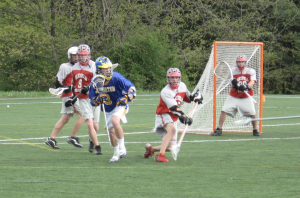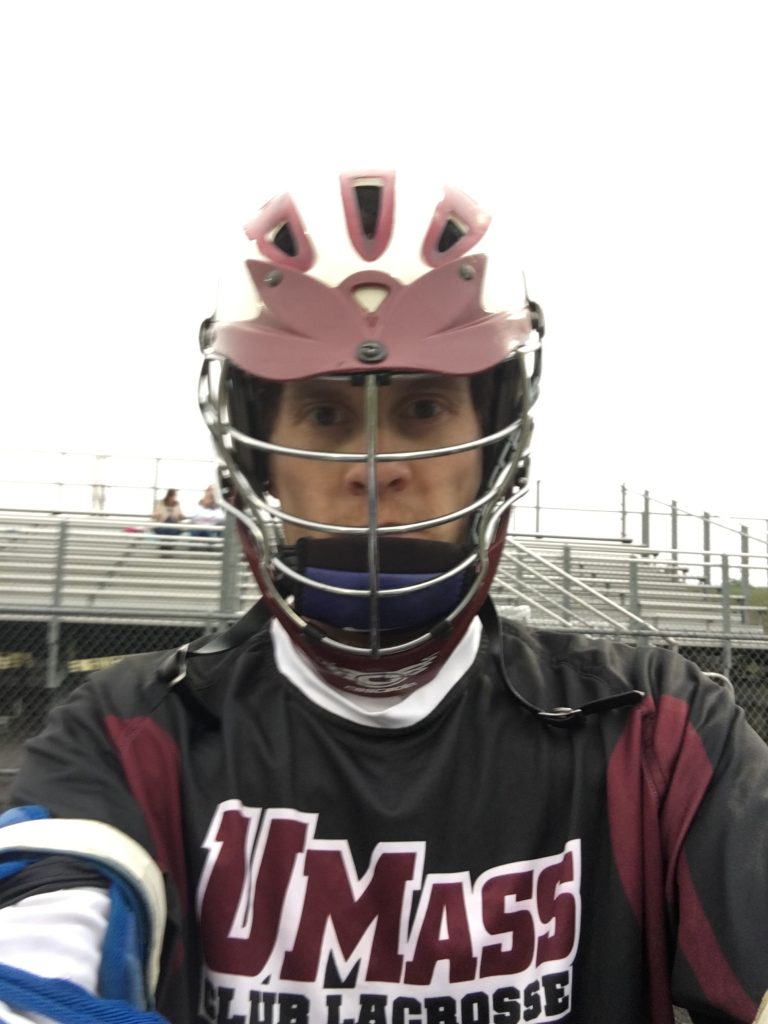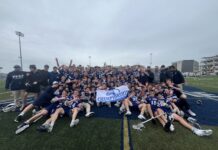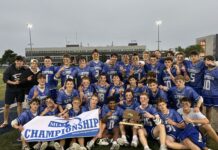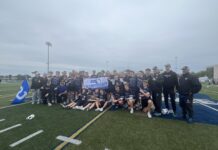Smith, an educator and former lacrosse standout at Lexington High School, discusses his battle against the rare disease Chorea-Acanthocytosis, and the importance and need for awareness, advocacy, and funding.
By Ryan Kilian and Drew Smith
“Tough, gritty, upbeat, funny, kind, and caring.” Those are just some of the many positive qualities that were mentioned by friends, former coaches, and former teammates when describing Drew Smith, on and off the lacrosse field.
Lexington native and former LHS lacrosse standout Drew Smith ‘06 had played lacrosse and hockey since he was a young boy growing up in the historic, suburban Boston community. Sports allowed Smith to shine in an environment, where he could use his qualities and attributes to shine bright on the field and ice.
Growing up, the youngest of five siblings (two older brothers and two older sisters). Drew and his family were active members of the Lexington community and avid sports participants and supporters. Sports were an integral part of Drew’s daily schedule, and they would progress and develop more, as he entered Lexington High School.
At fifteen years old, however, a routine blood test revealed abnormal muscle enzyme levels. Due to this medical news and the potential added stress that hockey could provide on Smith’s kidneys, he reluctantly gave up the game he had played and loved since his father took him out on the ice at just three years of age.
“When I heard these words, it felt like my heart had been thrown off a ten-story building,” Smith explained. “It was like the dagger had been shoved into my dreams and hopes and then the dagger was twisted continuously, destroying them all. Virtually nothing could cheer me up. Gradually, I realized that my health was at risk. Accepting the news of my condition, I would never have asked, “why me?” I compiled the medical advice in a mature and positive manner. I did not dwell on the situation and remained optimistic. I was not afraid of this disorder, I just felt empty without hockey.”
After a battery of future medical exams, and consulting with additional doctors, Smith was cleared to participate in all sports, including hockey.
“As much as I wanted to play, I understood that, more than any other sport, it worsened my condition,” Smith explained. “I do not regret the decision and feel wiser, as the situation made me confident that I can accept change. I had to broaden my outlook and revise my goals. I am thankful that I was able to strengthen my focus on academic excellence, excel in community service, and succeed in another sport: Lacrosse.”
Lacrosse: After being cleared by the doctor’s Smith turned his focus to lacrosse. Lacrosse provided Smith with a scholastic athletic focus and his high school coaches appreciated and valued having Drew as a member of their team.
“Drew is such a positive young man who comes from a great family,” Lexington High School lacrosse coach Dave Walsh told BostonLax. “As a player, Drew was a leader and a young man that just played so hard on the field. He was a lock to be a captain and was always a kid you could count on to leave it all on the field.”
After reconnecting with Smith in his post-playing days, Walsh was excited to introduce Drew to his current Minutemen team this Spring season.
“Drew just has an infectious personality and such a positive spirit that is important to share,” Walsh added.
Drew’s play on the lacrosse field was also widely lauded.
Former Lexington High School assistant lacrosse coach Jeff LoPresti – LHS ’98 (who is currently a coach at Austin Prep) recalls the experience of coaching Drew and the qualities and lacrosse skills that Drew possessed to have success on the field.
“Drew made coaching fun,” LoPresti recalled. “He is such a positive person. His smile and attitude make people want to be around him. He was also a great off-ball attackman. He was slippery, had smooth hands, was tough and he could finish.”
No play exemplified Drew Smith’s grit and lacrosse acumen more than one of the biggest plays in Lexington High School lacrosse history.
“I remember the play like it was yesterday,” Walsh recalled of the play that would highlight the April 2005 game. “In all my years of coaching, it has to be one of my all-time favorites.”
In a game against league rival and longtime lacrosse power, Winchester High School, it would be Smith who would come up with the goal that would go down in LHS lacrosse history.
“Winchester was always so strong,” LHS grad and former lacrosse standout Luke DiLillo told BostonLax. “They were always a team that beat up on us, but that game was different.”
DiLillo, who would go on to play lacrosse at Manhattan College in New York, is also a lifelong friend and longtime teammate of Smith.
“It was all Drew’s effort that allowed us to win that game,” DiLillo added. “Drewby (a nickname given to Smith by his friends and teammates) was a crease attackman for us, and a good one. We would feed him the ball; he would face dodge and score – all while in the midst of falling down.”
With the game tied at 5-5 and the clock ticking toward zero, DiLillo would pick off a pass at midfield, while Lexington was riding, and Winchester was attempting to clear. DiLillo would then carry the ball into the Winchester box, and he would find teammate Dylan Oteri. Oteri would only possess the ball for a few seconds, as he spotted and found a cutting Drew Smith – near the crease…. and Smith would complete the storybook win – with one of his patented finishes. This finish would propel Lexington to a 6-5 win over Winchester, and a win that is talked about and appreciated to this very day.
“I knew that once we got the ball into Drew’s hands that we were going to score and win the game,” DiLillo recalled. “It was a pretty sweet victory and a great moment that we all shared together – as a team.”
After looking at numerous Division 3 colleges to continue his education and passion for playing lacrosse, Smith would choose to attend the University of Massachusetts Amherst, where he would study Chemistry and become a member of the UMass club lacrosse team. Smith’s focus on education and sport would eventually lead him to his future calling, but an unanticipated obstacle would soon follow.
The Diagnosis, The Spirit, and The Fight: In 2014, at 27 years of age, Smith received more medical news that would challenge Drew physically, but never deter his inspiring determination and spirit.
“Before the diagnosis, I knew something was wrong when I had difficulty catching a lacrosse ball,” Smith explained. “Playing lacrosse since the sixth grade, throwing, and catching a lacrosse ball was second nature to me. Playing through high school and college, these skills were never a challenge. After many years of using these skills, in the spring of 2013, I found it strange that catching a lacrosse ball suddenly became a challenge. I thought maybe I was just rusty, but as the season progressed, my coordination did not improve.”
Eating also became more and more difficult for Smith, and he noticed other changes as well.
“My gait was off,” Smith explained. “I could not sit still, and tasks like holding a marker or picking up a pencil were challenging. I was grinding my teeth, clenching my jaw, and biting my lips. I knew something was wrong, so I spoke up and went to the doctors.”
Seeking an answer, Drew sought the medical opinion of a neurologist. The doctor ran several tests, performed an MRI, an EEG, did blood work, and performed a Whole Exome Sequencing Test, and the results led to the diagnosis of Chorea-Acanthocytosis.
Chorea-Acanthocytosis is an extremely rare genetic neurodegenerative disease. It is a progressive movement disorder that causes involuntary movements of the extremities, mouth, and tongue. There are approximately 500 to 1,000 people worldwide who suffer from it. It has similarities to Parkinson’s and Huntington’s Disease. It causes one’s gait to be unsteady and it impairs muscle and nerve functioning – often causing speech difficulty.
Accepting the news of his condition, Smith again, never asked, “why me?”. He collected medical advice in a proactive and determined manner and optimistically sought help and solutions when dealing with the condition.
“The more I learned, the more I understood the gravity of the condition,” Smith explained. “It was only one blood test, but a blood test that gave an answer to life. I found something else, something more unique. And a revelation of understanding of what life has to offer, it has given me the ability to live with a rare disease.”
DiLillo, who has been friends with Smith since they were both in the sixth grade, shared his admiration for his former teammate and attack-line mate (of 10 years through youth and high school lacrosse).
“He is always positive and upbeat. When I ask him how he is doing, he always says he is doing well. You never hear him complaining or feeling bad for himself. He is always researching his condition and his goal is to bring more awareness to this.”
The Educator and The Coach – After reflecting on his future career path, Smith focused his passion for education and sport and embarked on a career in education, coaching, and mentorship. Smith pursued opportunities as a ski instructor at Mount Snow in Vermont, as a teacher and coach at the Northwood School in Lake Placid, New York, getting a Master’s Degree in education from NYU, and teaching chemistry and coaching lacrosse at Belchertown High School.
Smith explains in his own words how the importance of education, his experience, and the importance of connecting the teacher and the student – and how it connects with his goals and his fight against Chorea-Acanthocytosis.
The Importance of Education – By Drew Smith
“My experiences in teaching, coaching, and mentoring students at Northwood helped to cement my desire to continue to build a career in education,” Smith further explained.“ Pursuing a master’s degree in science education helped mold me into a more effective educator and demonstrated my superior work ethic to prospective employers. I am confident that my professional and academic background, ambition, positive attitude, and desire to work with young people contributed to my success in the Clinically Rich Integrated Science Program, in Teaching Chemistry, at New York University’s Steinhardt School of Culture, Education, and Human Development. My master’s degree is one key building block in what will hopefully be a long-term career of thousand “aha” moments, victories on the playing field, and strong mentorship with students.
My personal and professional goals are to gain an understanding of each student in order to develop effective teaching strategies that meet their individual needs. Likewise, I have applied my teaching skills through coaching hockey, lacrosse, and strength training at Northwood and at BHS, the opportunity to coach student-athletes in sports that I have played for over 15 years further supports my desire to pursue a career in education, as I know I learned several invaluable lessons on the playing field and as a member of a team. After years of practice and experience, these sports fundamentals are now easy for me, but I recall the struggles in mastering them myself. As a result, I understand the challenges that the players face, from trying to stop effectively on the ice to attempting to confidently cradle a lacrosse stick. It is satisfying to watch the student athletes’ pride when they succeed and know that my personal instruction has contributed to their achievements. It is amazing to believe that I have dedicated 28 years of my life to formal and informal education! WOW!
After recently watching the movie Dazed and Confused – it made me think about the importance of education and the meaning of education. I believe that education is about: learning the student, teaching the student, and the relationship between learning and teaching. This might sound trivial, but I see it like this.
It is my personal and professional goal to gain an understanding of each student (the learning) to develop effective teaching strategies that meet the individual needs of students (the teaching). I believe that it is important to learn about the student and to be able to effectively teach that student. In addition, an assessment of their skills or knowledge will allow me to better understand their learning needs. I still hold this teaching philosophy and have grown and strengthened it in many ways.
I am still a teacher and a student! Although I may not be teaching or learning in a classroom environment at the moment, I try to teach others about my disease and learn more about this disease every day. I believe that it is important to learn about the student (in this case the disease), and to be able to teach the student (you the reader) – by sharing my story with you.”
Read more from Drew on his personal blog – here
Research and Awareness are Needed!
According to Rarediseases.info, while there are currently no specified treatments to prevent or slow the progression of chorea-acanthocytosis, the treatment is symptomatic and supportive. The importance of information, further research, and education is paramount in the fight against chorea-acanthocytosis.
Awareness, education, and understanding are the first steps, but action must come next – and come quickly. Applying the awareness with action steps can help support the people who battle the rare disease, chorea-acanthocytosis. Help with research can be instrumental and funding is needed.
The Massachusetts and National Lacrosse communities are such strong and tight-knit communities, who always impress and inspire in our ability to support each other through hardship and when in need. Please step up and click on the following links below the article, to help further educate yourselves on Chorea-Acanthocytosis and take action steps as a community to assist in any way possible.
Important Links
Advocacy for Neuroacanthocytosis Patients
Efficacy of Deep Brain Stimulation in a Patient with Genetically Confirmed Chorea-Acanthocytosis
Is DBS right for you? Ruth Walker explains



